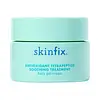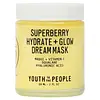What's inside
What's inside
 Key Ingredients
Key Ingredients

 Benefits
Benefits

 Concerns
Concerns

 Ingredients Side-by-side
Ingredients Side-by-side

Water
Skin ConditioningGlycerin
HumectantTridecyl Neopentanoate
EmollientCetearyl Ethylhexanoate
EmollientOlus Oil
EmollientPropanediol
SolventGlyceryl Stearate Citrate
EmollientAmmonium Acryloyldimethyltaurate/Vp Copolymer
Vitis Vinifera Seed Oil
EmollientIsosorbide Disunflowerseedate
HumectantIsosorbide Dicaprylate
Skin ConditioningTetrapeptide-14
Skin ConditioningEchium Plantagineum Seed Oil
Skin ConditioningAspalathus Linearis Extract
Skin ConditioningHydrolyzed Hyaluronic Acid
HumectantMel Extract
MoisturisingBoswellia Serrata Extract
Skin ConditioningCeramide NP
Skin ConditioningPhytosphingosine
Skin ConditioningCeramide AP
Skin ConditioningCholesterol
EmollientCeramide EOP
Skin ConditioningColloidal Oatmeal
AbsorbentRosa Damascena Flower Water
MaskingCucumis Sativus Fruit Water
Skin ConditioningSimmondsia Chinensis Seed Wax
Skin ConditioningOlea Europaea Husk Oil
Skin ConditioningHelianthus Annuus Seed Oil
EmollientCamellia Sinensis Leaf Extract
AntimicrobialAloe Barbadensis Leaf Juice
Skin ConditioningTocopherol
AntioxidantTrisodium Ethylenediamine Disuccinate
Butylene Glycol
HumectantXanthan Gum
EmulsifyingEthylhexylglycerin
Skin ConditioningSodium Lauroyl Lactylate
EmulsifyingCarbomer
Emulsion StabilisingPhenoxyethanol
PreservativePotassium Sorbate
PreservativeSodium Benzoate
MaskingCitric Acid
BufferingCI 75810
Cosmetic ColorantWater, Glycerin, Tridecyl Neopentanoate, Cetearyl Ethylhexanoate, Olus Oil, Propanediol, Glyceryl Stearate Citrate, Ammonium Acryloyldimethyltaurate/Vp Copolymer, Vitis Vinifera Seed Oil, Isosorbide Disunflowerseedate, Isosorbide Dicaprylate, Tetrapeptide-14, Echium Plantagineum Seed Oil, Aspalathus Linearis Extract, Hydrolyzed Hyaluronic Acid, Mel Extract, Boswellia Serrata Extract, Ceramide NP, Phytosphingosine, Ceramide AP, Cholesterol, Ceramide EOP, Colloidal Oatmeal, Rosa Damascena Flower Water, Cucumis Sativus Fruit Water, Simmondsia Chinensis Seed Wax, Olea Europaea Husk Oil, Helianthus Annuus Seed Oil, Camellia Sinensis Leaf Extract, Aloe Barbadensis Leaf Juice, Tocopherol, Trisodium Ethylenediamine Disuccinate, Butylene Glycol, Xanthan Gum, Ethylhexylglycerin, Sodium Lauroyl Lactylate, Carbomer, Phenoxyethanol, Potassium Sorbate, Sodium Benzoate, Citric Acid, CI 75810
Water
Skin ConditioningGlycerin
HumectantHelianthus Annuus Seed Oil
EmollientIsopropyl Myristate
EmollientGlyceryl Stearate
EmollientBetaine
HumectantCetyl Alcohol
EmollientStearic Acid
CleansingTetrahexyldecyl Ascorbate
AntioxidantOpuntia Tuna Flower/Stem Extract
Skin ConditioningEuterpe Oleracea Fruit Extract
Lycium Barbarum Fruit Extract
AstringentAristotelia Chilensis Fruit Extract
Skin ConditioningMoringa Oleifera Leaf Extract
Skin ConditioningGlyceryl Stearate Citrate
EmollientTocopheryl Acetate
AntioxidantGlyceryl Laurate
EmollientSqualane
EmollientCarbomer
Emulsion StabilisingHyaluronic Acid
HumectantAllantoin
Skin ConditioningPanthenol
Skin ConditioningEthylhexylglycerin
Skin ConditioningXanthan Gum
EmulsifyingPhenoxyethanol
PreservativeRiboflavin
Cosmetic ColorantTriethyl Citrate
MaskingCitrus Aurantium Dulcis Peel Oil
MaskingGamma-Undecalactone
PerfumingGamma-Decalactone
PerfumingTocopherol
AntioxidantLimonene
PerfumingWater, Glycerin, Helianthus Annuus Seed Oil, Isopropyl Myristate, Glyceryl Stearate, Betaine, Cetyl Alcohol, Stearic Acid, Tetrahexyldecyl Ascorbate, Opuntia Tuna Flower/Stem Extract, Euterpe Oleracea Fruit Extract, Lycium Barbarum Fruit Extract, Aristotelia Chilensis Fruit Extract, Moringa Oleifera Leaf Extract, Glyceryl Stearate Citrate, Tocopheryl Acetate, Glyceryl Laurate, Squalane, Carbomer, Hyaluronic Acid, Allantoin, Panthenol, Ethylhexylglycerin, Xanthan Gum, Phenoxyethanol, Riboflavin, Triethyl Citrate, Citrus Aurantium Dulcis Peel Oil, Gamma-Undecalactone, Gamma-Decalactone, Tocopherol, Limonene
 Reviews
Reviews

Ingredients Explained
These ingredients are found in both products.
Ingredients higher up in an ingredient list are typically present in a larger amount.
Carbomer is a polymer of acrylic acid. Its main role is to create a gel consistency.
A high amount of carbomer can cause pilling or balling up of products. Don't worry, most products contain 1% or less of carbomer.
Ethylhexylglycerin (we can't pronounce this either) is commonly used as a preservative and skin softener. It is derived from glyceryl.
You might see Ethylhexylglycerin often paired with other preservatives such as phenoxyethanol. Ethylhexylglycerin has been found to increase the effectiveness of these other preservatives.
Glycerin is already naturally found in your skin. It helps moisturize and protect your skin.
A study from 2016 found glycerin to be more effective as a humectant than AHAs and hyaluronic acid.
As a humectant, it helps the skin stay hydrated by pulling moisture to your skin. The low molecular weight of glycerin allows it to pull moisture into the deeper layers of your skin.
Hydrated skin improves your skin barrier; Your skin barrier helps protect against irritants and bacteria.
Glycerin has also been found to have antimicrobial and antiviral properties. Due to these properties, glycerin is often used in wound and burn treatments.
In cosmetics, glycerin is usually derived from plants such as soybean or palm. However, it can also be sourced from animals, such as tallow or animal fat.
This ingredient is organic, colorless, odorless, and non-toxic.
Glycerin is the name for this ingredient in American English. British English uses Glycerol/Glycerine.
Learn more about GlycerinGlyceryl Stearate Citrate is a citric acid ester of glyceryl stearate.
It is an emulsifier, emollient, and a surfactant.
Emulsifiers help stabilize a product. It does this by preventing certain ingredients from separating. Common ingredients include oils and water, which do not mix naturally. Emulsifiers have properties that help keep ingredients such as these together.
Emollients help soothe and soften the skin. They do this by creating a protective film on your skin. This barrier helps trap moisture and keeps your skin hydrated. Emollients may be effective at treating dry or itchy skin.
Surfactants help gather oils, dirt, and other pollutants from the skin. This helps them to be easily rinsed away.
Learn more about Glyceryl Stearate CitrateHelianthus Annuus Seed Oil is the oil derived from the seeds of a Sunflower. Sunflower seed oil is non-fragrant. It is an emollient, meaning it helps to soften the skin.
Sunflower seed oil contains many fatty acids. The fatty acids found in sunflower seeds include (from highest amount to least): linoleic acid, myristic acid, palmitic acid, stearic acid, arachidic acid, oleic acid, and linolenic acid.
These fatty acids help the skin create ceramides. Ceramides play a role in repairing the skin barrier.
Helianthus Annuus Seed Oil helps moisturize the skin. This in turn helps the skin look more rejuvenated and smoother.
Sunflowers are rich in vitamin E.
Historians believe Indigenous cultures of North America domesticated sunflowers before corn. Thus they relied on sunflower oil for a variety of uses. One such use is moisturizing skin and hair.
Sunflower seed oil may not be fungal acne safe. We recommend speaking with a professional if you have any concerns.
Learn more about Helianthus Annuus Seed OilPhenoxyethanol is a preservative that has germicide, antimicrobial, and aromatic properties. Studies show that phenoxyethanol can prevent microbial growth. By itself, it has a scent that is similar to that of a rose.
It's often used in formulations along with Caprylyl Glycol to preserve the shelf life of products.
Tocopherol (also known as Vitamin E) is a common antioxidant used to help protect the skin from free-radicals and strengthen the skin barrier. It's also fat soluble - this means our skin is great at absorbing it.
Vitamin E also helps keep your natural skin lipids healthy. Your lipid skin barrier naturally consists of lipids, ceramides, and fatty acids. Vitamin E offers extra protection for your skin’s lipid barrier, keeping your skin healthy and nourished.
Another benefit is a bit of UV protection. Vitamin E helps reduce the damage caused by UVB rays. (It should not replace your sunscreen). Combining it with Vitamin C can decrease sunburned cells and hyperpigmentation after UV exposure.
You might have noticed Vitamin E + C often paired together. This is because it is great at stabilizing Vitamin C. Using the two together helps increase the effectiveness of both ingredients.
There are often claims that Vitamin E can reduce/prevent scarring, but these claims haven't been confirmed by scientific research.
Learn more about TocopherolWater. It's the most common cosmetic ingredient of all. You'll usually see it at the top of ingredient lists, meaning that it makes up the largest part of the product.
So why is it so popular? Water most often acts as a solvent - this means that it helps dissolve other ingredients into the formulation.
You'll also recognize water as that liquid we all need to stay alive. If you see this, drink a glass of water. Stay hydrated!
Learn more about WaterXanthan gum is used as a stabilizer and thickener within cosmetic products. It helps give products a sticky, thick feeling - preventing them from being too runny.
On the technical side of things, xanthan gum is a polysaccharide - a combination consisting of multiple sugar molecules bonded together.
Xanthan gum is a pretty common and great ingredient. It is a natural, non-toxic, non-irritating ingredient that is also commonly used in food products.
Learn more about Xanthan Gum